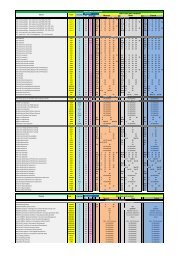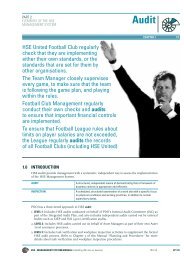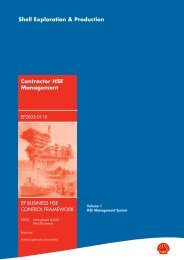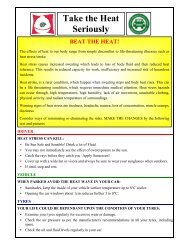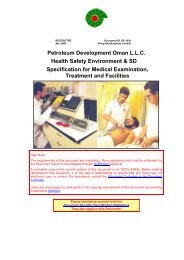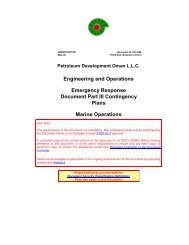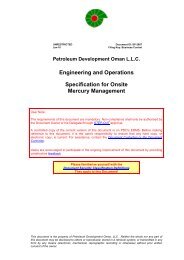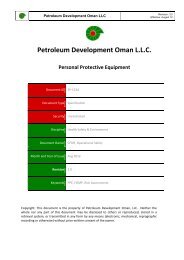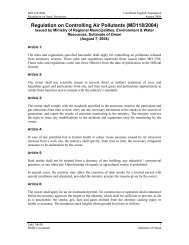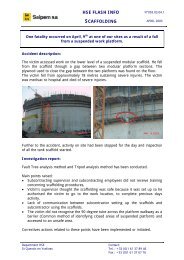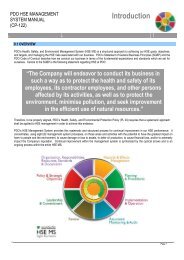CP-122 HSE Code of Practice - PDO
CP-122 HSE Code of Practice - PDO
CP-122 HSE Code of Practice - PDO
You also want an ePaper? Increase the reach of your titles
YUMPU automatically turns print PDFs into web optimized ePapers that Google loves.
HEALTH, SAFETY AND ENVIRONMENT<br />
CODE OF PRACTICE (<strong>CP</strong>-<strong>122</strong>)<br />
<strong>PDO</strong> <strong>HSE</strong> Management System Manual<br />
4.4.3 Scope <strong>of</strong> Quantitative Risk Assessments<br />
Quantitative Risk Assessments (QRA) are undertaken for more complex facilities or activities, and/or where required by law.<br />
Determining whether a qualitative or quantitative technique is to be used depends on the scope and complexity <strong>of</strong> the scenario<br />
being assessed. However, the application <strong>of</strong> quantitative methods is considered to be desirable under the following situations:<br />
<br />
<br />
<br />
<br />
<br />
When evaluating and comparing risk reduction options and where the relative effectiveness <strong>of</strong> these options is not obvious.<br />
When the exposure <strong>of</strong> the workforce, public or strategic value <strong>of</strong> the asset is high, and risk reduction measures are to be<br />
evaluated<br />
When novel technology is involved resulting in a perceived high level <strong>of</strong> risk for which no historical data is available<br />
When a demonstration that risks are being managed to a level which is as low as reasonably practicable (ALARP) is<br />
required.<br />
The application <strong>of</strong> QRA need not be limited to large, complex and expensive studies, however. It is a technique that can be<br />
applied quickly and inexpensively to help structure the solution to problems for which the solution is not intuitively obvious.<br />
Only staff with adequate training and experience should undertake QRA, although it is critical that personnel familiar with the<br />
operation or facility are involved in the study. QRA <strong>of</strong>ten involves the use <strong>of</strong> specialized s<strong>of</strong>tware.<br />
QRA provides a structured approach to assessing risk, whether the risks are human, hardware /<br />
s<strong>of</strong>tware failure, environmental events, and/or combinations <strong>of</strong> failures and events.<br />
QRA identifies high-risk areas, assists in efficient and effective risk management, and helps<br />
demonstrate that risks are being managed to a level deemed ALARP. Refer to SP 1258 –<br />
Quantitative Risk Assessment for further details on QRA.<br />
4.5 PROCEDURES – CONTROL<br />
4.5.1 Scope <strong>of</strong> Controls<br />
The third stage in HEMP, developing fit-for-purpose risk controls, requires use <strong>of</strong> appropriate risk control identification<br />
techniques, such as HAZOP / PR-1696, for example. Application <strong>of</strong> the technique chosen should cover:<br />
<br />
<br />
<br />
<br />
All activities, products, and/or services controlled by <strong>PDO</strong>, and those influenced by <strong>PDO</strong>, such as supplier, contractor,<br />
and sub-contractor activities.<br />
The activities, products, and/or services carried out by all personnel having access to the workplace and facilities at the<br />
workplace including suppliers, contractors, and/or sub-contractors.<br />
Routine (frequently performed), non-routine (infrequently performed), and/or emergency operating conditions and<br />
activities. Sometimes the categories <strong>of</strong> normal and abnormal operating conditions are also considered.<br />
The lifecycle <strong>of</strong> an asset or activity, from the planning stage, through operation to decommissioning, and disposal and<br />
restoration.<br />
Risk controls should include prevention, mitigation, and recovery measures. The following table illustrates the difference among<br />
these various types <strong>of</strong> controls:<br />
July 2011 Page 31



